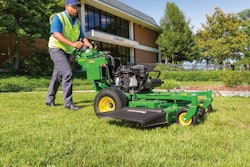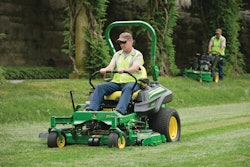When equipment, any equipment, does not work as it should, it is frustrating. It can mean costly repairs and then perhaps the worst part, lost hours and productivity. Professionals need their zero-turn mowers (ZTR) to be just as reliable and ready to go as any other machine in the fleet. One of the best ways to ensure dependable operation and good performance from a ZTR is a commitment to routine maintenance.
These are the five areas to watch when building a basic zero-turn mower maintenance program.
Note: Before proceeding with any maintenance, always consult the operator’s manual, wear appropriate safety gear, park the mower on a flat surface, and ensure the engine is off and cool.
1. Air Filter
Dirty air filters do more than hamper a mower’s performance, they create inefficient operation that wastes fuel. Worse yet, if they allow dirt and other debris to enter the engine, the result can be permanent damage.
Check the air filter at least monthly to assess its condition. Those who work in dry, dusty, or dirtier conditions may want to do this step more frequently, as well as those who are at the height of their busy season and are logging more daily hours on their ZTRs.
Furthermore, consider seasonality when establishing expectations for the air filter’s lifespan. Fall especially can be a drier time of year, with added tasks like bagging leaves putting greater stress on the filter. It is not uncommon for professionals to check the air filter weekly, even daily, during these peak times.
When it is time to change the filter (or filters, as some ZTRs have dual elements), first clear away any debris from the air intake area. A paper air filter can be gently tapped to remove excess debris, but never blow air on or attempt to clean a paper air filter. Instead, change the air filter as needed. Insert a new, clean air filter and take care to ensure no debris enters the engine.
----
Interested in Financing? *Sponsored by Bobcat*
2. Fuel Filter and Stabilizer
Like the air filter, a clean fuel filter keeps harmful particles from entering and damaging the engine and aids in efficient fuel consumption. The best time to change a fuel filter varies by ZTR so it is best to consult the operator’s manual as a guide, then check regularly, as appropriate.
Another factor that again affects the timing of filter changes is how much fuel is consumed, or how much the mower runs. The fuel filter may need to be changed often for companies that put a lot of hours on their ZTRs, but it may be a task that does not need as frequent attention for fleets that have other mowers sharing the workload.
When it is time to change a fuel filter, begin by placing a drain pan under it. Note the arrow on the existing fuel filter and the direction it is pointing. The new filter must be attached so that the arrow is pointing in the same direction.
Inspect the fuel filter and connecting hoses, looking for cracks or signs of excessive wear. Next, loosen the hose clamps and move them away from the filter. Disconnect the hoses from the old filter, then quickly reattach the new filter, making sure it is facing the correct way. Finally, reposition the hose clamps to ensure the filter is secure. Start the mower and let the engine run for a few minutes while checking for any leaks.
Do not neglect this important step when replacing a fuel filter: dispose of it in an environmentally responsible way. Most filters need to drain for a day, then disposal will vary according to local laws. Also, any spilled fuel and fuel-soaked towels should also be discarded in a proper manner.
Also, fuel-related, it is a good practice to add fuel stabilizer at certain times during the year. For cold-weather climates, stabilizer is common just ahead of winter months, in prep for ZTRs to sit idle for longer periods of time. However, this practice is smart for hot-weather climates as well, as stabilizer can prevent fuel from going bad any time it is expected that the mower will not be running for a while.
3. Engine Oil
Perhaps the most basic step of any equipment preventative maintenance is a daily oil check. While a homeowner only needs to change their mower engine oil annually, high-use commercial ZTRs demand more frequent changes. As with the air filter, the environment will dictate how often oil changes are required, with dry, dusty, and dirty conditions demanding more frequent changes.
An oil change is quick and easy for most professional equipment owners and operators. However, for those who are newer to the process or need a simple refresher, here is a quick step-by-step for how to change engine oil. Begin by placing a drain pan under the oil plug, along with a few towels down near the filter, and loosen the dipstick. Next, drain the oil. Many ZTRs have quick-drain valves. Replace the oil plug, then wipe down and clean the area. Replace the engine oil with a fresh fill and finally, replace the dipstick.
Run the engine for a minute, then shut it off and allow ample cool-down time. While the engine is cooling off, clean any spilled oil and dispose of the old oil and oil-soaked towels in a proper manner. Check with local regulations and, ideally, look for recycling options.
There is one final step before checking this job as complete. When the engine is cooled, check the oil level. Over-filling can damage the spark plug and lead to engine start issues.
4. Transmission Times Two
One may think that all commercial lawn mowers have virtually the same maintenance requirements. That is not far off from the truth. However, one thing that sets ZTRs apart from other commercial mowers are dual transmissions. Therefore, extra care to address the transmissions warrants one more step on the maintenance checklist.
Two of the first three tasks noted above, air filter and oil, are essentially the same process on the transmission as they are on the engine. Be diligent about checking the transmission’s filters and oil and changing when needed.
5. Daily and Regular To-Dos
There are a handful of miscellaneous tasks that should become part of a daily ZTR lawn mower maintenance routine, with others less frequent but still top of mind. Most of these involve simple checks, with larger efforts only on an as-needed basis.
Start every day by checking the mower’s tires and tire pressure. This is an important step for ZTRs, as low tire pressure on one side can throw off the transmissions and cause the mower to drift or pull to one side. Inadequate tire pressure also affects the quality of cut. Noting a low tire at the start of the day can uncover a bigger problem, like a puncture, that can be taken care of immediately.
Another simple morning check is the bagger, if one is being used. As mentioned earlier, fall is a particularly important time to check certain things more often, the bagger being one item to add to that list. Look for rips, holes, or other damage that would warrant replacement. Professionals who are covering a lot of acreage may even want to check the bagger multiple times a day, such as after every large job.
When starting up the mower each day, stop for a moment to listen. Every operator, whether veteran or newer to the job, can hear when something does not sound right. This can signal it is time to check the idlers or bearings.
Three things contribute to good airflow and quality of cut: a clean mower deck, good-condition belts, and sharp blades. At the end of each day, inspect the mower deck for excess debris to clear. As needed, remove the mower deck as instructed in the owner’s manual and clean the bottom side of the deck. Once a week, inspect the drive belt for worn or cracked areas and replace the belt, if needed. Also, remove and check the blade, looking for any signs of damage or excessive wear. Depending on the condition, a blade can be replaced or may just need to be sharpened. Many professionals find the blade to be one of the most important areas to check and will clean and sharpen on a weekly schedule.
Finally, give the ZTR a quick cleaning at the end of each day. This does not mean a full wash and dry, getting into every nook and cranny and polishing it up to look shiny and new. Simply blow off the machine with a handheld blower or compressor. Pay extra attention to the transmission area to prevent excess build up of debris.
Although it may sound time-consuming, basic maintenance is one of the easiest tasks, most cost-effective plans, and best investments professionals can make in their zero-turn mower. By giving it some simple, routine care, the ZTR will pay back with years of fast, dependable operation and beautifully cut grass.















![Gravely Pro Turn Mach One My23 Dsc03139 Edit 1200x800 5b2df79[1]](https://img.greenindustrypros.com/mindful/acbm/workspaces/default/uploads/2025/10/gravely-pro-turn-mach-one-my23-dsc03139-edit-1200x800-5b2df791.BucBnDoN22.jpg?ar=16%3A9&auto=format%2Ccompress&fit=crop&h=135&q=70&w=240)




